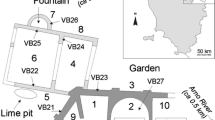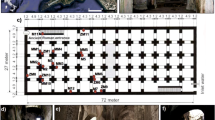Abstract
The article focuses on the stratigraphy of the late Byzantine pavement of the Southwest Church, Umm el-Jimal, Jordan and the production technology of their mortars by applying thin section petrography, x-ray diffractometry (XRD) and scanning electron microscopy with energy dispersive x-ray spectrometry (SEM-EDS). Investigations revealed the similarity between the studied pavement and standard Roman mosaic pavements. The pavement consists of four layers (statumen, rudus, nucleus and bedding), but lacks the tessellatum layer. The statumen was constructed using large stones and then leveled by soil and pebbles, while the other three layers are composed of lime-based mortars formed by two different recipes. The white-beige non-hydraulic mortar of the bedding layer consists of a lime binder and aggregates of scoria and organic fibers, and a Binder:Aggregate (B:A) ratio of 1:2. The grey hydraulic mortars of the rudus and nucleus are mixtures of lime and silica-rich silt/clay, fine sand, volcanic rocks, ceramics, and charcoal; and B:A ratios of 1:4. The rudus and nucleus mortars have high values of hydraulic and cementation indices, reflecting their hydraulic properties, which most probably originated from the reaction between lime, ceramic and volcanic inclusions. In contrast, lack of ceramic and absence of the reactions between lime and scoria of the bedding layer probably produced a mortar with low values of hydraulic and cementation indices, but durable and resistant to weight load.










Similar content being viewed by others
Data availability
No datasets were generated or analysed during the current study.
References
Al-Bashaireh K (2015) Radiocarbon Age determinations of Mosaic Mortar layers of churches from North Jordan. Radiocarbon 57(5):851–863
Al-Bashaireh K (2016) Use of lightweight lime mortar in the construction of the west church of Umm el-Jimal, Jordan: Radiocarbon dating and characterization. Radiocarbon 58(3):583–598
Al-Bashaireh K (2019) Lime mortar and plaster from the house XVII-XVIII, Umm el-Jimal, Jordan: archaeometric analysis. Shedet 6(6):212–224
Al-Bashaireh K (2023) Reconstructing the Chronology of Building the Southwest Church of Umm El-Jimal, Jordan by AMS Radiocarbon Dating of Mortar and Plaster. Radiocarbon, (accepted)
Al-Bashaireh K, Hwari W, Al-Tamimi M (2019) Multicolored Mosaic Tesserae used in the Girmil Church, East Gerasa, Jordan: a microfacial analysis and provenance determination. Jordan J Earth Environ Sci 10:227–233
Arinat M, Shiyyab A, Al Sekhaneh W (2020) Analytical characterization of ancient Mosaic Floor Preparatory layers and Tesserae from the Hippolytus Hall in Madaba, Jordan: Case Study. Mediterranean Archaeol Archaeometry 20(3):149–158
Arizzi A, Cultrone G (2021) Mortars and plasters—how to characterise hydraulic mortars. Archaeol Anthropol Sci 13(9):144
Bakolas A, Biscontin G, Moropoulou A, Zendri E (1995) Characterization of the lumps in the mortars of historic masonry. Thermochimica Acta 269:809–816
Borsoi G, Silva AS, Menezes P, Candeias A, Mirão J (2019) Analytical characterization of ancient mortars from the archaeological roman site of Pisões (Beja, Portugal. Constr Build Mater 204:597–608
Butler HC (1913) Ancient Architecture in Syria, Southern Syria: umm Idj-Djmâl. Division II. Brill, Leiden
Butler HC (1929) Early churches in Syria: fourth to seventh centuries. Amsterdam, Hakkert
Caldeira B, Oliveira RJ, Teixidó T, Borges JF, Henriques R, Carneiro A, Peña JA (2019) Studying the construction of floor mosaics in the Roman Villa of Pisões (Portugal) using noninvasive methods: high-resolution 3D GPR and photogrammetry. Remote Sens 11(16):1882. https://doi.org/10.3390/rs11161882
Callebaut K, Elsen J, Van Balen K, Viaene W (2001) Nineteenth century hydraulic restoration mortars in the Saint Michael’s Church (Leuven, Belgium): natural hydraulic lime or cement? Cem Concr Res 31(3):397–403
De Vries B (1985) Urbanization in the basalt region of north Jordan in late antiquity: the case of umm El-Jimal. Stud History Archaeol Jordan 2(2):249–256
De Vries B (1990) Umm el-Jimal: gem of the Black Desert; a brief guide to the antiquities. Amman, Al Kutba
De Vries B (1994) What’s in a name: the anonymity of ancient umm El-Jimal. Biblical Archaeologist 57(4):215–219
De Vries B (1998) Umm el-Jimal: a Frontier Town and its Landscape in Northern Jordan, volume I: field work 1972–1981. Supplementary Series. Journal of Roman Archaeology, p 26
De Vries B (2016) Archaeology for the future at umm el-Jimal: Site Preservation, Presentation, and Community Engagement. Newsl Am Cent Orient Res 28(1):1–5
Degryse P, Elsen J, Waelkens M (2002) Study of ancient mortars from Sagalassos (Turkey) in view of their conservation. Cem Concr Res 32(9):1457–1463
Dumbabin KMD (1999) Mosaics of the Greek and Roman World. Cambridge University Press, New York
Dunn E, Rapp G (2004) Characterization of mortars and pozzolanic materials from umm Al-Jimal. Stud Conserv 49(3):145–160
Eckel EC (1907) Cements, limes, and plasters: their materials, manufacture, and properties. Breinigsville, John Wiley & Sons
Elsen J (2006) Microscopy of historic mortars—a review. Cem Concr Res 36(8):1416–1424
Elsen J, Brutsaert A, Deckers M, Brulet R (2004) Microscopical study of ancient mortars from Tournai. (Belgium) Mater Charact 53(2–4):289–294
Elsen J, Mertens G, Van Balen K (2011) Raw materials used in ancient mortars from the Cathedral of Notre-Dame in Tournai (Belgium). Eur J Mineral 23(6):871–882
Ergenc D, Fort R, Varas – Muriel MJ, Alvarez de Buergo M (2021) Mortars and plasters—how to characterize aerial mortars and plasters. Archaeol Anthropol Sci 13(11):197
Ergenç D, Fort R (2019) Multi-technical characterization of roman mortars from Complutum. Spain Meas 147:106876. https://doi.org/10.1016/j.measurement.2019.106876
Fichera GV, Belfiore CM, La Russa MF, Ruffolo SA, Barca D, Frontoni R, Galli G, Pezzino A (2015) Limestone provenance in Roman Lime-Volcanic Ash mortars from the Villa dei Quintili. Rome Geoarchaeology 30(2):79–99
Gilento P, Pesce C, Pesce G (2019) Analysis of mortar samples from the Church of the Saints Sergius and Bacchus at Umm as-Surab (Jordan). In Proceedings of 5th Historic Mortars Conference – RILEM Proceedings PRO 130, José Ignacio Álvarez, José María Fernández, Íñigo Navarro, Adrián Durán, Rafael Sirera (editors), RILEM Publications, Paris, pp.713–726
Glueck N (1942) Nabataean Syria. Bull Am Schools Orient Res 85(1):3–8
Haddad M (2019) A paradigm for local ecclesiastical architecture in Jordan, comparative study of three churches at Umm el-Jimal. Unpublished master thesis, the University of Jordan
Hamarneh C, Abu-Jaber N (2017) Mosaic pavement mortar production in Gerasa in the byzantine period. Archaeol Res Asia 9:22–33
Ibrahim KM, Tarawneh K (2003) Phases of activity and geochemistry of basaltic dike systems in northeast Jordan parallel to the Red Sea. J Asian Earth Sci 21(5):467–472
Izzo F, Arizzi A, Cappelletti P, Cultrone G, De Bonis A, Germinario C, Graziano SF, Grifa C, Guarino V, Mercurio M, Morra V (2016) The art of building in the roman period (89 BC–79 AD): mortars, plasters and mosaic floors from ancient Stabiae (Naples, Italy). Constr Build Mater 177:129–143
Leslie AB, Hughes JJ (2002) Binder microstructure in lime mortars: implications for the interpretation of analysis results. Q J Eng GeolHydrogeol 35(3):257–263
Miriello D, Barca D, Bloise A, Ciarallo A, Crisci GM, De Rose T, Gattuso C, Gazineo F, La Russa MF (2010) Characterisation of archaeological mortars from Pompeii (Campania, Italy) and identification of construction phases by compositional data analysis. J Archaeol Sci 37(9):2207–2223
Pachta V, Stefanidou M (2018) Technology of multilayer mortars applied in ancient floor mosaic substrates. J Archaeol Science: Rep, (20), 683–691
Pachta V, Stefanidou M, Marinou M (2018) Development and testing of repair mortars for floor mosaic substrates. J Building Eng 20:501–509
Pliny P The Elder (1962) Naturalis Historiae (Natural History). X:LebriXXXVI–XXXVII with an English Translation by Eichholz, D.E. Harvard University Press, Cambridge, Massachusetts, London, England
Ravi R, Thirumalini S, Taher N (2018) Analysis of ancient lime plasters–reason behind longevity of the Monument Charminar, India a study. J Building Eng 20:30–41
Rispoli C, De Bonis A, Guarino V, Graziano SF, Di Benedetto C, Esposito R, Cappelletti P (2019) The ancient pozzolanic mortars of the thermal complex of Baia (Campi Flegrei, Italy). J Cult Herit 40:143–154
Rossi F (1970) Mosaics. A survey of their history and techniques. Pall Mall, London
Secco M, Dilaria S, Addis A, Bonetto J, Artioli G, Salvadori M, Aquileia (2018) Italy) Archaeometry, 60(2), 185–206
Seymour LM, Maragh J, Sabatini P, Di Tommaso M, Weaver JC, Masic A (2023) Hot mixing: mechanistic insights into the durability of ancient roman concrete. Sci Adv 9(1):1602
Shaw JE, Baker JA, Menzies MA, Thirlwall MF, Ibrahim KM (2003) Petrogenesis of the largest intraplate volcanic field on the arabian plate (Jordan): a mixed lithosphere–asthenosphere source activated by lithospheric extension. J Petrol 44(9):1657–1679
Stewart J (2004) Conservation of archaeological mosaic pavements by means of reburial. Conserv Manage Archaeol Sites 6(3–4):237–246
Taylor HF (1997) Cement chemistry, vol 2. Thomas Telford, London
Vitruvius (1960) The Ten Books on Architecture, Translated by Morgan, Morris Hicky. Dover Publications, INC, New York
Yaseen I, Abidrabbu AY (2016) Mineralogy, Petrology and Geochemistry of the Basalt flows at Ash-Shun Ash-Shamaliyya Area, North West Jordan. Earth Sci 5(6):82–95
Acknowledgements
The authors acknowledge the Humboldt Foundation for supporting this research and the Curt-Engelhorn‐Zentrum Archäometrie gGmbH CEZA for hosting the first author and allowing use of their facilities to conduct the research. We are also grateful to Dr. Christoph Berthold and Dr. Silvia Amicone (University of Tübingen) for performance of the XRD analysis.
Funding
The first author was funded by fellowship from the Alexander von Humboldt-Stiftung, Germany and hosted by the CEZA Archaeometry Center (CurtEngelhorn-Zentrum Archäometrie gGmbH), Germany.
Author information
Authors and Affiliations
Contributions
Al-B.K wrote the main manuscript text and prepared figures. I.S Edited the manuscript and added some paragraphs, prepared Fig. 10, carried out the SEM-EDS analysis.
Corresponding author
Ethics declarations
Conflict of interest
The authors have no conflicts of interest to declare.
Competing interests
The authors declare no competing interests.
Additional information
Publisher’s Note
Springer Nature remains neutral with regard to jurisdictional claims in published maps and institutional affiliations.
Rights and permissions
Springer Nature or its licensor (e.g. a society or other partner) holds exclusive rights to this article under a publishing agreement with the author(s) or other rightsholder(s); author self-archiving of the accepted manuscript version of this article is solely governed by the terms of such publishing agreement and applicable law.
About this article
Cite this article
Al-Bashaireh, K., Stepanov, I. The pavement layers of the Southwest Church of Umm el-Jimal, Jordan: stratigraphy and archaeometric characterization. Archaeol Anthropol Sci 16, 63 (2024). https://doi.org/10.1007/s12520-024-01964-z
Received:
Accepted:
Published:
DOI: https://doi.org/10.1007/s12520-024-01964-z




